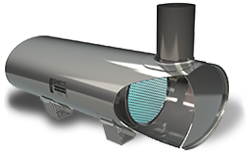Check our 3-Way Catalytic Converters designed especially for gasoline and gaseous LSI and SSI engines
What Are LPG Emissions?
The major harmful emissions from LPG engines are similar to those from other internal combustion engines:
- Carbon monoxide (CO)
- Hydrocarbons (HC)
- Nitrogen oxides (NOx)
Unlike diesel engines, there are practically no particulate emissions from LPG engines. Concentration ranges of particular emissions are listed in Table 4.
| CO | HC | NOx |
|---|---|---|
| vol. % | ppm C1 | vppm |
| 0.2 - 2 | 50-750 | 250 - 2,000 |
Carbon monoxide is generated in the exhaust as the result of incomplete combustion of fuel. CO is a very toxic, colorless and odorless gas. LPG emissions may contain considerable amounts of CO. When engines operate in enclosed spaces, such as warehouses, buildings under construction, or tunnels, carbon monoxide can accumulate quickly and reach concentrations which are dangerous for humans. It causes headaches, dizziness, lethargy, and death. CO is usually the major concern whenever LPG engines are used indoors.
Hydrocarbons are also a product of incomplete combustion of fuel. LPG emissions, because of the composition of fuel, contain only short chain hydrocarbons. They are not likely to contain toxic components which are found in gasoline HC emissions. Also the environmental impact of LPG hydrocarbon emissions (ozone reactivity contributing to smog) is much smaller than that of gasoline. However, hydrocarbon derivatives are responsible for the characteristic smell which is often a nuisance when LPG engines operate indoors.
Nitrogen oxides are generated from nitrogen and oxygen under the high temperature and pressure conditions in the engine cylinder. NOx consists mostly of nitric oxide (NO) and some nitrogen dioxide (NO2). Nitrogen dioxide is a reactive gas, very toxic for humans. Accumulation of NOx in a warehouse atmosphere may be also detrimental for the stored goods. For example, only a few ppm of NOx in the ambient air can change the color of paper stock from white to yellowish. NOx emissions are also a serious environmental concern because of their ozone reactivity and important role in smog formation.
Nett Technologies’ 3-Way Catalytic Converters

Request A Quote
Photo Gallery

